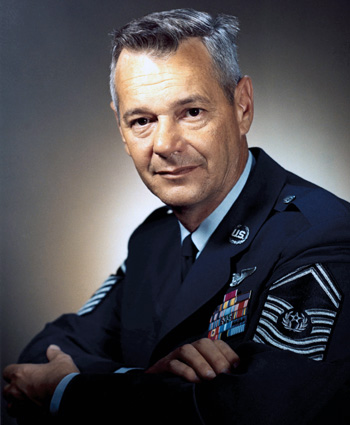
|
Paul W. Airey |
 |
|||
| Rank, Service | ||||
Chief Master Sergeant of the Air Force, USAF |
||||
| Veteran of: | ||||
|
||||
| Tribute: | ||||
Paul Airey was born on December 13, 1923, in New Bedford, Massachusetts. He enlisted in the U.S. Army Air Forces on November 16, 1942, and following basic training at Atlantic City, New Jersey, he went to Scott Field, Illinois, where he completed Radio Operator School in June 1943. Sgt Airey then attended Aerial Gunnery School at Tyndall Field, Florida, from June to August 1943, followed by B-24 Liberator combat crew training. His first assignment was as a B-24 radio operator and aerial gunner with the 52nd Bomb Squadron at Gowen Field, Idaho, from November to December 1943, and then as a B-24 radio operator and aerial gunner with the 831st Bomb Squadron of the 485th Bomb Group at Fairmont AAF, Nebraska, from December 1943 to March 1944. Sgt Airey deployed with the 831st to Venosa Airfield, Italy, in March 1944, and he was forced to bail out of his crippled bomber while flying his 28th combat mission over Vienna, Austria, on July 8, 1944. He was immediately captured and taken as a Prisoner of War, being first held at Stalag Luft 4 near the Baltic Sea, and then force-marched hundreds of miles to Stalag 11B in Fallingbostel, Prussia. After spending 299 days in captivity, he was released on May 2, 1945. After recuperating from his injuries, MSgt Airey served as a Radio Operator Mechanic and First Sergeant with the 3505th Air Force Base Unit at Scott Field, Illinois, from November 1945 to August 1948, and then as a Communications Technician and First Sergeant with the 3314th Training Squadron and the 3310th Technical Training Group at Scott AFB from August 1948 to September 1951. His next assignment was as Non-Commissioned Officer-in-Charge (NCOIC) of Communications with the 6351st Air Base Wing at Naha AB, Okinawa, from October 1951 to September 1953, and then as First Sergeant with the 3310th Technical Training Group at Scott AFB from October 1953 to September 1958. MSgt Airey served as as First Sergeant in the 3380th Technical Training Group at Keesler AFB, Mississippi, from September 1958 to September 1959, followed by service as First Sergeant of the 611th Air Command and Warning Squadron in Japan from September 1959 to August 1960. SMSgt Airey next served as NCOIC of the Airman Section and then Personnel Sgt Major with the 478th Fighter Group at Grand Forks AFB, North Dakota, from September 1960 to October 1961, and then First Sergeant of the 468th Consolidated Aircraft Maintenance Squadron at Grand Forks AFB from October 1961 to June 1963. CMSgt Airey then served as First Sergeant of the 18th Fighter-Interceptor Squadron at Grand Forks AFB from June 1963 to January 1965, followed by service as First Sergeant of the 4756th Civil Engineer Squadron at Tyndall AFB, Florida, from January 1965 until he was named the first Chief Master Sergeant of the Air Force on March 30, 1967, serving in that position from April 3, 1967, to July 31, 1969. As CMSAF, Airey served as an advisor to the Secretary of the Air Force and the Chief of Staff of the Air Force in the Pentagon on matters concerning welfare, effective utilization, and progress of the enlisted members of the Air Force. His final assignment was as School Secretary of the 4756th Combat Crew Training Squadron at Tyndall AFB from September 1969 until his retirement from the Air Force on August 1, 1970. Paul Airey married the former Shirley E. Babbitt of Quincy, Massachusetts, on February 2, 1946, and they had three children together; Ellen, Dale, and Shawn. He died on March 11, 2009, and was buried at Arlington National Cemetery in Arlington, Virginia. |
||||
|
||||

